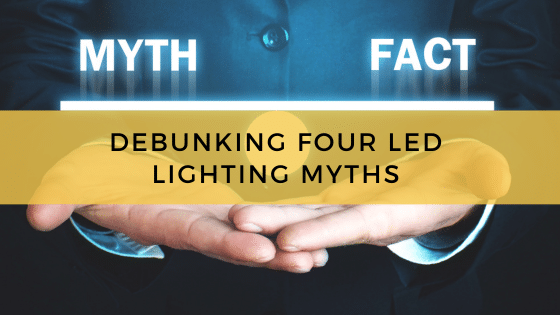
Disproving Four Common Myths About LED Lighting
LED technology is taking over the lighting industry, and for good reason. LED bulbs offer excellent energy savings, an extended lifespan, instant startup, and many other benefits. But even as LED lighting makes progress, myths about the technology are still widespread.
Let’s address four of the most stubborn myths surrounding LED bulbs and shed some light on the truth of the technology.
Myth #1: LED Lighting is Too Expensive
This is perhaps the most persistent myth regarding LED lighting, causing many companies to avoid installing LED lights for fear of their perceived cost.
LED lights cost more than older types of light bulbs, but this fact only speaks to the upfront cost. There is also ongoing operating costs that need to be considered. This includes:
- The cost of energy consumption
- The cost of lamp replacement
- The cost of lost productivity (due to poor lighting quality)
LED lamps have the advantage in all three areas over all other forms of lighting. LED fixtures are the most energy efficient available, with significant advantages over fluorescent tubes, metal halides, halogen, and other technologies. Part of this advantage is derived from the lamp itself, which uses a sophisticated semiconductor chip instead of filaments or pressurized gas. An additional advantage is due to LED’s directional nature. LED bulbs cast illumination directionally instead of omnidirectionally (like fluorescents and metal halides) – meaning they can be aimed with precision. As a result, less power is needed to get enough light to the target.
As for maintenance and lamp replacement – a high quality LED bulb will last for at least 50,000 hours, which adds up to about 12 years of 12-hours-a-day illumination before replacement is needed. Compare this to fluorescent tubes (about 20,000 hours) and metal halides (10,000 hours at most), and the replacement cost advantage is rather clear.
Modern LEDs also produce high quality illumination that can facilitate greater productivity. Their brilliant output is similar to sunlight in emission range, so it’s the next best thing to natural sunlight. For many workers, this is a welcome change from the green pallor (and headaches) that fluorescent tubes are known for. Research shows that retrofitting LED lighting comes with a modest per-worker productivity boost. For large facilities that rely on hundreds or thousands of workers, this added productivity can offset overhead costs.
Add it all up and LED’s operational cost advantage means a return on investment in as short as a couple of years.
Myth #2: LED Lights Are Not as Bright as Older Lighting Technologies
LED lights were not immediately embraced by the industry as first-generation LEDs could not compete in lighting output or quality.
That is to be expected with any new technology, but LED lighting has definitely made up the gap. High quality LEDs now generate more lumens per watt than all other lighting options. That means more light per unit of energy spent.
LED fixtures and lamps can also be scaled up to any degree, including massive stadium sportslighters that can throw 50,000 or more lumens. And again, because LEDs are directional, more of that light reaches its intended target.
LED lights are also available in neutral and cooler color temperatures that are usually perceived as brighter, compared to warmer lamps. With these facts in mind, it is no surprise that LEDs are also replacing older street lighting technologies, like high pressure sodium lamps, as they support better night-time visibility.
Myth #3: LED Lighting Produces Zero Heat
Another benefit of LED’s energy efficiency is its low heat output. Since the technology wastes very little energy on thermal waste, it outputs a fraction of the heat that other lights put out. As such, LED lights tend to be a safer option and less burdensome on a facility’s HVAC systems.
However, no lighting system can be 100 percent efficient, and the same is true of LED lighting technology. A tiny amount of heat is generated as part of the lighting process, and this heat needs to be controlled to preserve the lamp’s reliability. Poor internal heat regulation will lead to early LED failure.
That is why LED lighting manufacturers include heat sinks with every lamp. Onboard heat sinks are responsible for capturing and dispersing thermal energy, ensuring it does notcollect around the light and affect its performance. So, while LEDs are not exactly heat-free, they do manage thermal waste in a much more efficient and controlled way.
Myth #4: LED Lights Emit Unsafe Levels of Blue Light
Blue light may be an emerging health concern among medical researchers, as this energizing light can disrupt circadian rhythms and therefore affect sleep quality. LEDs have been blamed for outputting blue light, perhaps owing to LED’s reputation as a cooler light.
However, multiple lighting agencies have reported that the blue light emitted by LEDs is no more concerning than the blue light emitted by other lighting products. When controlling for color temperature (cooler lights do emit more blue illumination than warm lights), the amount of blue light emitted by LED lighting is no different than other sources.
Fact: LEDs Are the Present and Future of Lighting Technology
The truth is that LED lighting is quickly replacing older lights in a wide array of applications. In 2018, almost half of all commercial buildings were utilizing LED lighting to some degree. That number is significantly higher now.
No technology is perfect, of course, but LED lighting is in the best position, among all lighting options, to get as close to perfect as possible. Since its introduction decades ago, LED lights have improved in quality and reliability, while dropping in costs. Since LED lighting is a relatively new technology compared to other lighting options there is still plenty of room to improve LED engineering and optimize lighting products further. Contact your lighting expert today to start your journey into creating a brighter future.






